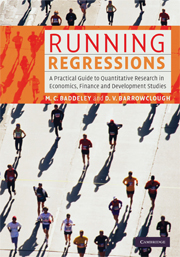 Running Regressions
Running Regressions Book contents
- Frontmatter
- Contents
- List of figures
- List of tables
- List of boxes
- Acknowledgements
- List of acronyms
- How to use this book
- Part I Simple regression and data analysis
- 1 An introduction to Ordinary Least Squares
- 2 Running simple regressions
- 3 Using logs and estimating elasticities
- 4 Hypothesis testing
- Part II Multiple regression and diagnostic testing
- Part III Time-series econometrics
- Part IV Advanced topics
- Index
- References
3 - Using logs and estimating elasticities
Demand for air travel
Published online by Cambridge University Press: 05 June 2014
- Frontmatter
- Contents
- List of figures
- List of tables
- List of boxes
- Acknowledgements
- List of acronyms
- How to use this book
- Part I Simple regression and data analysis
- 1 An introduction to Ordinary Least Squares
- 2 Running simple regressions
- 3 Using logs and estimating elasticities
- 4 Hypothesis testing
- Part II Multiple regression and diagnostic testing
- Part III Time-series econometrics
- Part IV Advanced topics
- Index
- References
Summary
Economic issues include:
Inverse demand curves
Elasticities
Income and substitution effects
Normal, inferior and Giffen goods
Econometric issues include:
Model specification: using logs to estimate elasticities
Running regressions using Excel
Hypothesis testing: one-tailed t tests
Data issues include:
Data constraints
Proxy variables
The issue
If you were the manager of the London Underground or American Airlines would you raise ticket prices, or drop them? Which strategy would maximise your firm's profits? The ‘law of demand’ states that if prices are lowered then there will be rises in demand. But this doesn't necessarily mean that a firm should just lower prices if it wants to boost revenue. Other effects operate too and the net result will depend on how sensitive consumers are to changes in price. If for some reason consumers are determined to have only a certain amount of a particular good or service then lowering prices may make little difference to the amount demanded and so a firm's revenues might fall because they are selling similar quantities but at lower prices. For example, if you manage an airline and your consumers don't care much about price; if they are not motivated to travel more even when flights are cheaper, then total revenues would fall, perhaps so much that costs could not be covered (and you would probably be looking for a new career).
- Type
- Chapter
- Information
- Running RegressionsA Practical Guide to Quantitative Research in Economics, Finance and Development Studies, pp. 64 - 85Publisher: Cambridge University PressPrint publication year: 2009


